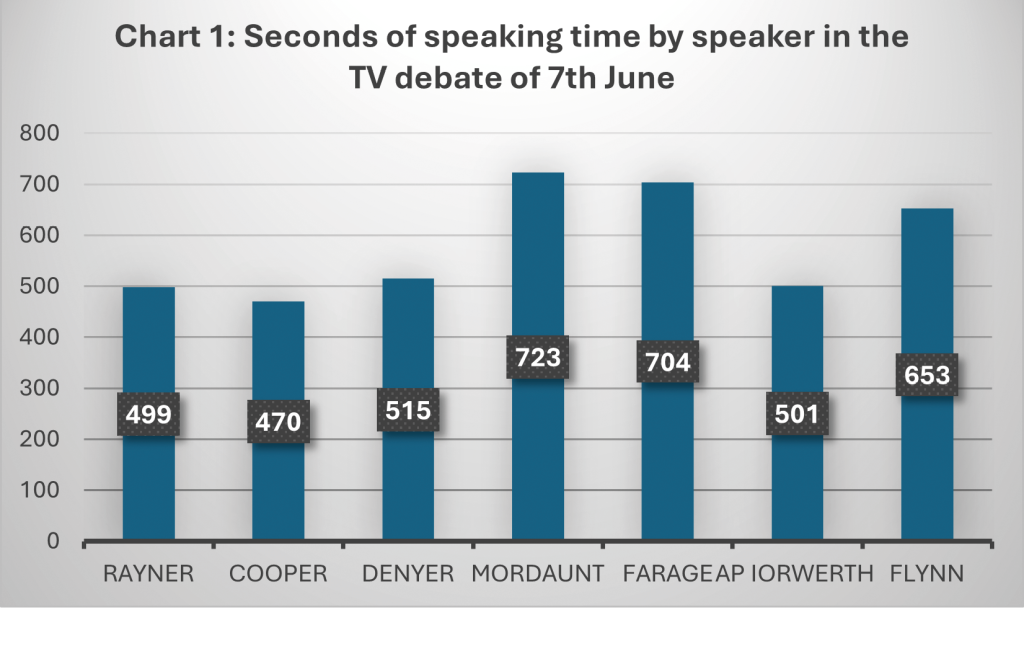
Dr Sylvia Shaw
Senior Lecturer in English Language and Linguistics at the University of Westminster. She has published ‘Gender, Power and Political Speech’, an analysis of the TV debates of the 2015 General Election (with Professor Deborah Cameron). Her monograph ‘Women, Language and Politics’ was published in 2020.

UK Election 2024
Section 8: Personality politics and popular culture
87. Ed Davey: Towards a Liberal Populism? (Dr Tom Sharkey, Dr Sophie Quirk)
88. Why Nigel Farage’s anti-media election interference claims are so dangerous (Dr Lone Sorensen)
89. Nigel Farage and the political circus (Dr Neil Ewen)
90. Binface, Beany and Beyond: humorous candidates in the 2024 General Election (Prof Scott Wright)
91. What Corbyn support reveals about how Starmer’s Labour won big (Prof Cornel Sandvoss, Dr Benjamin Litherland, Dr Joseph Andrew Smith)
92. “Well that was dignified, wasn’t it?”: floor apportionment and interaction in the televised debates (Dr Sylvia Shaw)
93. TV debates: beyond winners and losers (Prof Stephen Coleman)
94. Is our television debate coverage finally starting to match up to multi-party politics? (Dr Louise Thompson)
95. Tetchiness meets disenchantment: capturing the contrasting political energies of the campaign (Prof Beth Johnson, Prof Katy Parry)
96. “We’re just normal men”: football and the performance of authentic leadership (Dr Ellen Watts)
97. ‘Make the friendship bracelets’: gendered imagery in candidates’ self-presentations on the campaign trail (Dr Caroline Leicht)
98. Weeping in Wetherspoons: generative Al and the right/left image battle on X (Simon Popple)
99. An entertaining election? Popular culture as politics (Prof John Street)
100. Changing key, but keeping time: the music of Election 2024 (Dr Adam Behr)
101. Truth or dare: the political veracity game (Prof John Corner)
The General Election televised debates of 2024 were distinctive in that there were two seven-party debates between ‘leading figures’ on 7th and 13th June. In the first, Mishal Husain moderated a debate for the BBC with Penny Mordaunt for the Conservatives, Labour’s Angela Rayner, Liberal Democrat Daisy Cooper, Stephen Flynn from the Scottish National Party, Rhun ap Iorwerth from Plaid Cymru, Carla Denyer from the Green Party, and Nigel Farage from Reform UK.
These multi-party TV debates are highly competitive events in which the speakers’ ability to take the floor is key to their success. Although the moderator’s role is to regulate equal participation of all members, this rarely happens in practice and speakers’ floor allocation is often highly variable. In this debate, the speaking time of each speaker is shown in the Chart 1.

This shows that Penny Mordaunt took the floor for the most time, followed by Nigel Farage and Steven Flynn. Previous research has shown that incumbents gain more floorspace in debates because other candidates and the moderator address more direct questions and criticisms towards them which offers them more speaking turns, and this appears to be the case here. As the primary political opponent for many of the parties, Angela Rayner also gained more speaking turns because of direct challenges and questions, mainly from Mordaunt. However, Rayner did not capitalise on this advantage and instead consistently used up less time on her routinely allocated speaking turns where she was not competing for the floor.
Given the lack of the advantages of the additional speaking turns afforded to the main players, it was Farage, Denyer and Flynn who accrued the most space on the debate floor by successfully interrupting, confronting other speakers and making asides and wisecracks in other speakers’ turns. These are all strategies that have been identified as markers of successful speakers in debates because they can manipulate the ‘key’ of the debate from a serious tone to a mocking, ironic or humorous one, and thus help to construct speakers’ authority and authenticity. The second debate in this format on ITV on 13th June (moderated by Julie Etchingham) followed a similar pattern where it was the smaller parties that made up the most interactional ground with interruptions, interjections and wisecracks.
The position of the speakers on the stage for both debates was arranged by drawing lots, and the placement of Rayner and Mordaunt next to each other in the first debate allowed one of the most distinctive features of this debate – direct challenges mainly from Mordaunt towards Rayner. These were illegal in terms of the debate rules, and frequently broke the debate discourse down into two-way or ‘dyadic’ exchanges between the two speakers which excluded other participants. These two speakers often resisted the moderator’s attempts to stop the exchanges and continued to speak at the same time as each other for sustained periods (something that happens very rarely in spontaneous speech because it renders both speakers inaudible). The refusal of either of these speakers to give way to each other, the confrontational nature of their exchanges, accompanied by Mordaunt jabbing a pointing finger at Rayner, can be seen as risky behaviour in the context of political TV debates.
Debate participants must carefully balance the impression that they make on the audience, often in ‘double bind’ situations where they must appear strong but not aggressive, eloquent but not glib, and friendly but not obsequious. Gender plays a part here too, as women politicians in the 2015 General Election debates have been shown to have been judged much more harshly than their male counterparts when speaking in positions of authority. They were represented in ways that re-attached them to female stereotypes and archetypes (mother, seductress, pet, iron maiden) in media coverage. Here, Mordaunt and Rayner risked being judged harshly for being ‘too aggressive’; ‘too argumentative’ and ‘too forceful’ as women politicians, a precarious position that was exploited by Carla Denyer who interjected “That was extremely dignified, wasn’t it?”, after a particularly heated exchange between Mordaunt and Rayner.
Apart from a few references to the ‘feisty’ Mordaunt and Rayner (a ubiquitous sexist word only used of women and animals) in the news media following this debate, there was little evidence of them being described in sexist terms as bossy head girls, matrons and headmistresses. Their exchanges were described in less sexist albeit fairly negative ways as ‘slugging it out’; ‘clashing’ and ‘chaotic’ with a focus on debate content (particularly Mordaunt’s criticism of Sunak leaving the D-Day commemorations early), rather than the women politicians’ appearance. Refreshingly, it appears that the media representations of this debate have improved in terms of sexist tropes and judgements since 2015.
